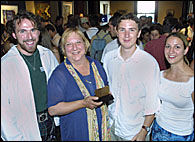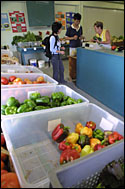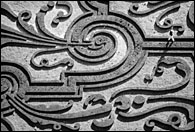On campus
Grads just wanna have fun
 PGSS President Ron McTaggart-Cowan, Dean Martha Crago, PGSS VP External David Wise and PGSS VP Internal Krystyna Zaluski at Monday's orientation bash.
PGSS President Ron McTaggart-Cowan, Dean Martha Crago, PGSS VP External David Wise and PGSS VP Internal Krystyna Zaluski at Monday's orientation bash.PHOTO: Owen Egan |
|
The Post Graduate Students' Society executives don't want to miss out on their own opportunity for frosh madness, so they've planned a fun-filled week up at their McTavish St. digs, Thomson House. They kick-started the events on Monday with honouring Dean of Graduate and Postdoctoral Studies Martha Crago by naming a room after her. After the snazzy plaque was unveiled, a beaming Crago and her entourage ascended to the ball room for wine and cheese. Principal-elect Heather Munroe-Blum and several deans joined in the revelry, and Principal Bernard Shapiro addressed the crowd, reminding the students not to tarry with their work. "You'll win the Nobel for your next project, not this one."
Today at 11 am, starting from Thomson House, a tour goes to old Montreal for rollerblading, biking, walking or cruising at the Old Port. From 5 pm to 9 pm, the Thomson House bar hosts a scotch tasting for all peat-loving swillers. On Friday night, go to the house warming party: happy hour, 5 pm to 7 pm, DJs start at 8 pm and spin till the wee hours.
All graduate and postgraduate students are members of Thomson House, 3650 McTavish, and have access to the tasty lunchtime restaurant, bar, and many comfy and elegant rooms in which to meet pals, relax or raise a pint. Members can play snooker on the third floor, take dance lessons and go to movie nights. Check out the website for events and info all year at www.pgss.mcgill.ca.
Get your juicy, sweet melons!
 Ann Baisley rings up fresh veg purchases at Mac Market
Ann Baisley rings up fresh veg purchases at Mac MarketPHOTO: Owen Egan |
|
Care for a sweet apple? Shiny purple peppers? Red and tasty tomatoes that remind you what summer tastes like?
Then drive to Macdonald campus and follow the signs to Mac Market, where you can buy seedless watermelons, cherry tomatoes, canary melons, leeks, Spanish onions, eggplants and tiger babies (the basketball-sized red watermelons, not the kittens).
Senior Technician of Horticul-ture, Plant Science Department, Jean Pierre Laplaine says that the campus has been selling its wares "forever." The money they make goes back into the department, towards hiring students for the summer and machinery repairs.
Produce is spanking fresh and most of it is grown on campus. The garlic comes from a local grower who uses no pesticides. "It's more expensive, but when you cut it, there's juice inside - it's not dehydrated," Laplaine says. Honey also comes from off-campus.
Prices are definitely competitive. Fill up a huge bag of peppers, any colour, for $4.50, and watermelons are about a buck a kilo. A basket of about 5 or 6 lbs of tomatoes sets you back a mere $3.50.
It's not too late for a picnic!
Open Monday to Friday, 10 am to 5 pm; Saturday and Sunday, 10 am to 4 pm; until Halloween, after which phone 398-7875 for hours. Mac Market stays open until there's nothing left to sell.
Tune in to history
 |
|
History does indeed repeat itself. CBC Radio One has started broadcasting a series of lectures that took place at McGill last spring on IDEAS, their program of contemporary thought. Hitting the airwaves will be the successful "Public Memory, Citizenship, and History Education" talks that had been organized by the McGill Institute for the Study of Canada, the departments of History and Integrated Studies in Education, and the Education International Office.
"One of the great things about this kind of broadcast is that it brings into the public sphere debates and disagreements that are usually confined to academic circles," said Anthony Paré, chair of Integrated Studies in Edu-cation, "the kinds of debates that are too often held behind closed doors."
The lecture series discussed the role education plays in answering questions like why history is important and what it means for Canadian identity.
The program kicked off the series with Professor Desmond Morton's contentiously titled "Canadian History: What is the big deal?" on September 6. They will continue to broadcast lectures from the series every Friday until October 4.
If you missed the lectures the first time around, or wanted to hear one again, tune in to CBC radio One, 9 pm, on the following days:
- September 13: Peter Seixas, "What Is Historical Consciousness?"
- September 20: Timothy J. Stanley, "Whose Public? Whose Memory? Racisms, Education and Nationalist History in Canada."
- September 27: Keith Barton, "Committing Acts of History: Humanistic Education and Participatory Democracy."
- October 4: Jocelyn Létourneau, "Remembering Our Past: An Examination of Young Quebeckers Historical Memory."
Gazing from the sky
 Gardens at the Château of Vaux-le-Vicomte, Maincy, Franc
Gardens at the Château of Vaux-le-Vicomte, Maincy, FrancPHOTO: Yann Arthus-Bertrand |
|
McGill art-lovers have gotten quite a treat since June 5, when the University's lower grounds and the west side of McGill College Ave. were transformed into an open-air gallery for Montreal's biggest outdoor photo show.
Called the Earth From Above, the exhibit features 120 giant photographs by French photographer Yann Arthus-Bertrand. Taken from altitudes of 30 to 3,000 metres, each image measures six feet by four feet and features unusual aerial scenes from Africa to New York City.
The University played several important roles in the show's delivery. Derek Drummond, Vice-Principal (Development & Alumni Relations), helped convince the exhibit sponsor to hold part of the show by McGill's Roddick Gates.
That's where the pièce-de-résistance, a huge map of the world that people can walk on, was displayed to help put each photo into context. Four students from McGill's School of Architecture built the platform for the map with Keith Roche, Moyse Hall's technical manger. Angelo Tambasco and Giovanni Nuzzi, from McGill's Buildings and Ground Services, ensured the surrounding property was landscaped.
The exhibit's most daunting challenge was reserved for Howard Davies, adjunct professor from the School of Architecture and an architect at Atelier Big City. Davies and his firm were asked to design the weatherproof showcases that have held and protected each of Arthus-Bertrand's prints throughout the summer.
Davies worked on a short time-line to create 62 modules, each eight feet wide by 10 feet high, that could withstand rain, sun and especially wind. All photo stands were bolted to the sidewalk with six-inch screws, he says. "These modules needed to be secure and not budge, since we couldn't risk anything falling on pedestrians."
Considering local weather, Davies would have preferred to construct each module out of galvanized steel, but Arthus-Bertrand insisted the stands be fabricated from his preferred material, wood, which was painted beige to offset each photo. Modules needed to include lights to illuminate photos at night.
The architect also had to ensure the stands wouldn't be too massive. "We needed modules big enough to hold each photo, but we didn't want to block or destroy the view of McGill College Avenue," he recalls, noting that conceptualizing the framework for an outdoor gallery wasn't easy. "It's not like we could compare them to anything else, since there's never been an exhibit like this on McGill College, much less in Montreal."
The Earth From Above exhibit also permitted the McGill Bookstore to boost business throughout the summer. The bookstore operated a kiosk at the Roddick Gates and sold hundreds of coffee-table books, La Terre Vue du Ciel by Arthus-Bertrand, as well as thousands of postcards depicting images from the show.
The Earth From Above exhibit, which was originally scheduled to end Sept. 15, has been extended until Oct. 31.

